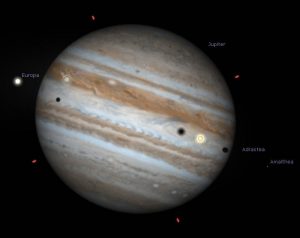Hi Star gazers,
I hope you got some clear skies in January and February. You did not hear much from me these past few month as I have been in such diverse locations as Townsville, Uluru (Ayres Rock) & Cruising the Tasman sea as the resident Astronomer aboard the Viking Orion as seen in the image here with the moon, Venus & Saturn putting on a nice show.

Meanwhile back here in the Far north of Qld we have the odd clear patch in the evening sky. However from where ever you are in the world there are certain things you will see.
The Autumn Equinox
From anywhere in the world the sun will rise in the east and set in the west on the 21st of March (AEST). For those of us in the southern hemisphere it means the sun moving a little further in the north each day. The days will get cooler and the nights longer (great for astronomy).
The Solar Minimum
We now find that our sun is at the depth of the solar minimum cycle, which comes around every 11 years and this is certainly a deep solar minimum. For those of you who like to follow the procession of sunspots across the face of the sun, you would have needed to find something else to do in February as not a single sunspot graced the surface of our sun. Only in the last 15 or so years has it really been understood by science, just how much these solar minimums can influence our weather on earth. This is due to the increased bombardment of cosmic rays into our atmosphere. Showing us we are part of a much bigger “Eco System”
Galaxies on the Ecliptic

Wherever you are you will be able to clearly see the constellations of the Ecliptic. While the early evening sky is dominated by Gemini (the Twins) with its many star clusters. One of the most interesting and prominent constellations of the late evening sky this time of year is Leo (The Lion) I find Leo particularly interesting as, by following along the belly of the lion, towards its legs and beyond into the void towards the bright Star Vindamatrix in Virgo, you find a surprising host of Galaxies. To the astute astronomer with clear dark skies & a moderate to large telescope will be treated to over 20 bright Galaxies between the belly of Leo and Virgo. Almost all of these Galaxies were catalogued by the 18th Century Astronomer Charles Messier who wanted to plot these fuzzy Nebulae in his telescope of the day. To our larger and higher quality telescopes of today we see structure in these distant Galaxies of the Virgo supercluster. The best examples are probably M65 & M66 above the bright Star Chertan in Leo, visible even with smaller scopes, as seen in the image here. Also know as the Leo “Smiley Face” galaxies

The Northern and Southern skies
Northern Skies

If you are north of Brisbane, the most interesting constellation visible in the lower Northern Sky is Ursa Major “The Big Bear” or as the major asterism (pattern) within the constellation is know as the “Big Dipper” or “The Plough”. This will be well know if you hail from or have spent some time in the northern hemisphere. What ever you know it as you will see it rising in the North East around 10pm and most prominent from 12 to 1 am across March and April. There are several Messier Galaxies around the “Dipper” one of the most interesting however is the Whirlpool Galaxy above the bright star Alkaid at he end of the dipper handle, a bright pair of Galaxies in the process of merging. A fate that will one day befall our own Milky Way Galaxy and Andromeda.
Southern Skies

Looking to the southern sky, you cant help but for your eye to be drawn to the southern cross and its deceiving companion above “The false Cross”. Between the two you will find a fuzzy patch even with the naked eye. It is a collection of star clusters and what must be the best nebula in the southern sky, Eta Carina. Seen easily with binoculars, a telescope reveals dark molecular clouds bright stars & the glowing nebulosity that is the Eta Carina Nebula, a star forming region with one of the most highly unstable stars in our Galaxy at its centre.
So if your skies are clear there is lots to do in March and April & we have plenty of great telescopes to suit all budgets and circumstances at Night Sky Secrets to help you discover these and more delights.
Clear Skies
Ian Maclean


